continuousWave --> Whaler --> Cetacea
Previous | Next
![[Logo: WHALER CETACEA]](graphics/cetaceaLogo230x60Trans.gif)
Cetacea: Page 2
These photographs first appeared March 26, 2000.
Send your photographs for inclusion in this rotating gallery!
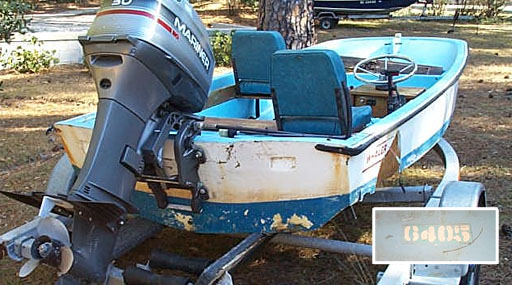 |
1962 Sport 13
Older, smaller whale(r)s have survived for almost 40 years in the wild,
but sometimes show the scars of those years.
This 1962 Whaler 13 Sport has just been captured and
moved onshore for recovery.
The inset shows the serial/hull number, "6405."
The original cut down transom has been filled to accomodate
the longshaft 30 HP '96 Mariner, and the stainless steel wheel is probably
an upgrade from the original. "I'm hoping to have it ready in 4-5 weeks,"
says owner A.J. Kress.
PhotoCredit: <ajkress@goalindustries.com>
|
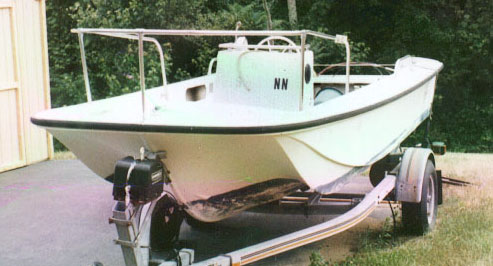 |
1972 Whaler 16 Bass Boat
Occasionally older whale(r)s show up and you're not quite
sure what model they are. David Vergara wondered what this hull was.
The interior is white with a raised bow platform from the console forward.
The hull forms makes it definitely pre-1976.
Larry Goltz though it was a Bass Boat, with a owner-added
railing at the bow. David contacted the factory with the
hull number and found out it was made June 15, 1972
and it was a Bass Boat (in production 1971-1975).
Pretty good records, and pretty good eye, Larry!
Now we need to see the "after" pictures.
How's that restoration coming, David?
PhotoCredit: David Vergara <vergara@mediaone.net>
|
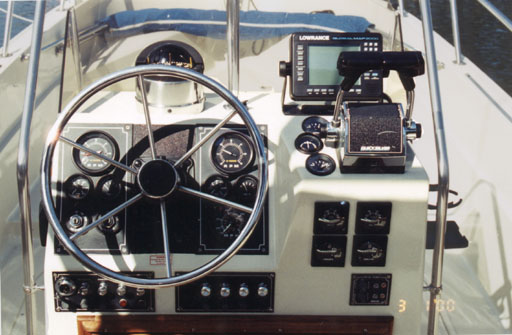 |
Console Detail, 1989 Outrage 25 WHALE LURE
- Behind the wheel: Tach(2), Water Pressure(2), and
Cylinder Head Temp(2) gauges, plus Speedo and ignition switches.
- At the controls: Trim(2) and Engine RPM Synchronizer gauges.
- Below the controls: Voltage(2) and Hour(2) meters.
- Across the bottom: Switch panels(2) and Bilge Pump controls.
- Across the top: Richie Navigator Compass and Lowrance Global Map 2000
combination DGPS Chartplotter and Sonar.
|
The twenty-five foot Outrages are among the larger whale(r)s,
and are definitely pelagic in nature.
They roam the seas, and have evolved a very purposeful and
functional propulsion and control system, as seen here.
Speaking of helm consoles, I just hate those things that
look like part of a GM car dash. Well, this one is
definitely not your father's Oldsmobile.
I get a sense of power just looking at it!
Imagine cruising along thirty miles offshore with the twin 200 Mercs
roaring back there on the transom bracket...awesome!
PhotoCredit: Larry Goltz
|
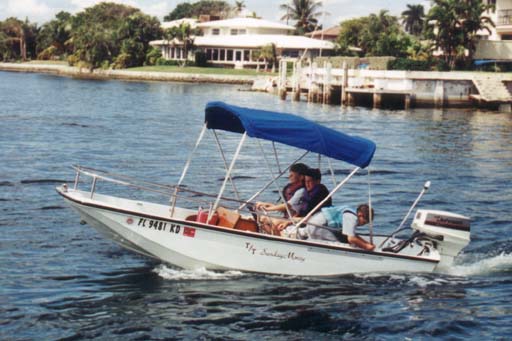 |
c.1988 Super Sport 13 Custom White Gelcoat
When this mint condition Classic Whaler was retired as a yacht tender,
the father of these three kids bought it.
Now they're out enjoying a day on the water under their Newport Blue Mills Canvas Suntop.
What other 13-foot boat would you let your kids take out for a spin on the intercoastal?
I know when I was a kid, I loved those times I got to take the boat out without Dad along.
PhotoCredit: Larry Goltz
|
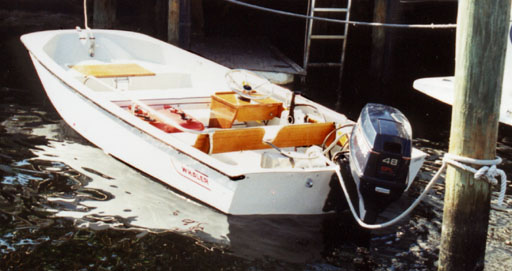 |
Sport 13 with 48 HP!
This Floridian whale(r) has developed an extra powerful propulsion
unit. High speed movements may be necessary for
survival in the dense aquatic population of the intercoastal waterway.
Her interior features another variant on the seatback option;
the railing doesn't seem to continue across the cockpit.
PhotoCredit: Larry Goltz
|
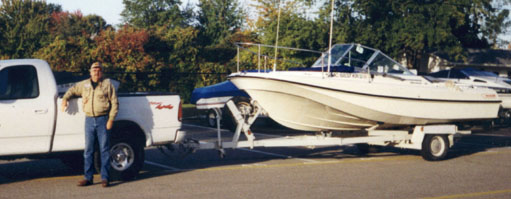 |
1974 Revenge 19
Many whale(r)s have adapted to an amphibious role, equally at
home on land or sea. In nautically named Anchorville, Michigan,
Detloff brothers Dennis and Don (shown) have restored
BOTTOM SCRAPER. She features a 165 Hp Mercruiser stern drive
powered by a straight-six Chevy
and lots of newly replaced teak trim.
PhotoCredit: Don Detloff
|
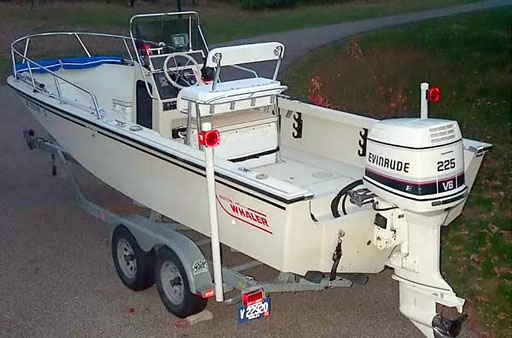 |
1992 Outrage 22 OUTRÉ
This fine specimen of the Outrage genus has adapted to annual
land migrations between northern Michigan and southern Florida
by growing these rather prominent rearward-facing eye stalks.
In summer months OUTRÉ can be seen in her marine environment,
close to Neptune Island in Lake Huron's North Channel.
PhotoCredit: John Flook
|
continuousWave --> Whaler --> Cetacea
Previous | Next
DISCLAIMER: This information is believed to be accurate but there is no
guarantee. We do our best!
The page has been accessed times.
Copyright © 1999, 2000 by James W. Hebert. Unauthorized reproduction prohibited!
This is a verified HTML 4.0 document served to you from continuousWave
URI: http://continuouswave.com
Last modified:
Author: James W. Hebert

![[Logo: WHALER CETACEA]](graphics/cetaceaLogo230x60Trans.gif)





